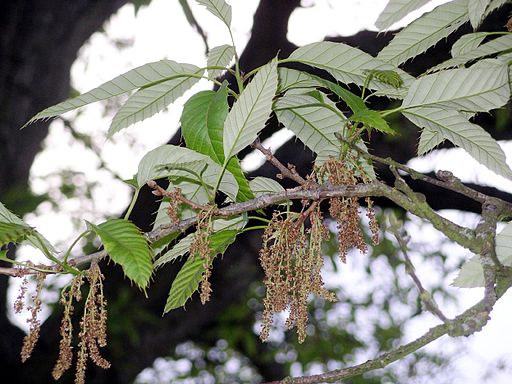Classification System: APG IV
Superregnum: Eukaryota
Regnum: Plantae
Cladus: Angiosperms
Cladus: Eudicots
Cladus: Core eudicots
Cladus: Rosids
Cladus: Eurosids I
Ordo: Fagales
Familia: Fagaceae
Genus: Quercus
Species: Quercus variabilis
Name
Quercus variabilis Blume, 1851
Synonyms
Homotypic
Pasania variabilis (Blume) Regel, Cat. Pl. Hort. Aksakov.: 102 (1860).
Heterotypic
Quercus chinensis Bunge, Enum. Pl. China Bor.: 61 (1833).
Quercus moulei Hance, J. Bot. 13: 363 (1875).
Quercus bungeana F.B.Forbes, J. Bot. 22: 83 (1884).
Quercus serrata var. chinensis Wenz., Jahrb. Königl. Bot. Gart. Berlin 4: 221 (1886).
Quercus variabilis var. pyramidalis T.B.Chao, Z.I.Chang & W.C.Li, Acta Phytotax. Sin. 19: 117 (1981).
Quercus variabilis var. zhongtiaoensis D.F.Ke & X.M.Liu in S.C.Li & al. (ed.), Dendrol. Zhongtiaoshan.: 324 (1995).
Distribution
Native distribution areas:
Continental: Asia-Temperate
Regional: China
China North-Central, China South-Central, China Southeast
Regional: Eastern Asia
Japan, Korea, Taiwan
Regional: Indian subcontinent
Tibet
Continental: Asia-Tropical
Regional: Southeastern Asia
Vietnam
References: Brummitt, R.K. 2001. TDWG – World Geographical Scheme for Recording Plant Distributions, 2nd Edition
References
Primary references
Blume, C.L. 1849–1851. Museum Botanicum Lugduno-Batavum sive stirpium Exoticarum, Novarum vel Minus Cognitarum ex Vivis aut Siccis Brevis Expositio et Descriptio. Leiden. Volumen 1. BHL Reference page. : 1:297.
Additional references
Govaerts, R.H.A. & Frodin, D. 1998. World Checklist and Bibliography of Fagales (Betulaceae, Corylaceae, Fagaceae and Ticodendraceae). VIII + 408 p. The Board of Trustees of the Royal Botanic Gardens, Kew. ISBN 1-900347-46-6. Reference page.
Chang, C.S., Kim, H. & Chang, K.S. 2014. Provisional checklist of vascular plants for the Korea peninsula flora (KPF). 563 p. Seoul: T.B. Lee Herbarium. PDF Reference page.
Iwatsuki, K., Boufford, D.E. & Ohba, H. (eds.) (2006). Flora of Japan IIa: 1-550. Kodansha Ltd., Tokyo.
Links
Govaerts, R. et al. 2021. Quercus variabilis in World Checklist of Selected Plant Families. The Board of Trustees of the Royal Botanic Gardens, Kew. Published on the internet. Accessed: 2021 Jul 04. Reference page.
Govaerts, R. et al. 2021. Quercus variabilis in Kew Science Plants of the World online. The Board of Trustees of the Royal Botanic Gardens, Kew. Published on the internet. Accessed: 2021 Jul 04. Reference page.
International Plant Names Index. 2021. Quercus variabilis. Published online. Accessed: Jul 04 2021.
Tropicos.org 2021. Quercus variabilis. Missouri Botanical Garden. Published on the internet. Accessed: 2021 Jul 04.
Hassler, M. 2021. Quercus variabilis. World Plants: Synonymic Checklists of the Vascular Plants of the World In: Roskovh, Y., Abucay, L., Orrell, T., Nicolson, D., Bailly, N., Kirk, P., Bourgoin, T., DeWalt, R.E., Decock, W., De Wever, A., Nieukerken, E. van, Zarucchi, J. & Penev, L., eds. 2021. Species 2000 & ITIS Catalogue of Life. Published on the internet. Accessed: 2021 Jul 04. Reference page.
Hassler, M. 2021. World Plants. Synonymic Checklist and Distribution of the World Flora. . Quercus variabilis. Accessed: 04 Jul 2021.
USDA, ARS, Germplasm Resources Information Network. Quercus variabilis in the Germplasm Resources Information Network (GRIN), U.S. Department of Agriculture Agricultural Research Service. Accessed: 07-Oct-06.
Vernacular names
English: Chinese Cork Oak
magyar: Paráskérgű tölgy
日本語: アベマキ
한국어: 굴참나무
русский: Дуб изменчивый
Quercus variabilis, the Chinese cork oak, is a species of oak in the section Quercus sect. Cerris, native to a wide area of eastern Asia in southern, central, and eastern China, Taiwan, Japan, and Korea.[2]
Description
Quercus variabilis is a medium-sized to large deciduous tree growing to 25–30 metres (82–98 ft) tall with a rather open crown, and thick corky bark with deep fissures and marked by sinuous ridges. The leaves are simple, acuminate, variable in size, 8–20 centimetres (3.1–7.9 in) long and 2–8 centimetres (0.79–3.15 in) broad, with a serrated margin with each vein ending in a distinctive fine hair-like tooth; they are green above and silvery below with dense short pubescence.[2]
The flowers are wind-pollinated catkins produced in mid spring, maturing about 18 months after pollination; the fruit is a globose acorn, 1.5–2 centimetres (0.59–0.79 in) diameter, two-thirds enclosed in the acorn cup, which is densely covered in soft 4–8 millimetres (0.16–0.31 in) long 'mossy' bristles.[2][3]
Foliage and flowers
Trunk and bark of Chinese cork oak
Chinese cork oak planted at Meise, Belgium
Distribution and habitat
Evergreen and deciduous forests; below 3,000 metres (9,800 ft). Anhui, Fujian, Gansu, Guangdong, Guangxi, Guizhou, Hebei, Henan, Hubei, Hunan, Jiangsu, Jiangxi, Liaoning, Shaanxi, Shandong, Shanxi, Sichuan, Taiwan, Yunnan, Zhejiang, Japan and Korea.[2]
Uses
It is cultivated in China to a small extent for cork production, though its yield is lower than that of the related cork oak. It is also occasionally grown as an ornamental tree. For pharmaceutical grade production of Ganoderma lucidum, known in China as ‘the mushroom of immortality,’ the dead wood logs of Q. variabilis are used.[4]
References
"Quercus variabilis Blume". World Checklist of Selected Plant Families (WCSP). Royal Botanic Gardens, Kew – via The Plant List.
Huang, Chengjiu; Zhang, Yongtian; Bartholomew, Bruce. "Quercus variabilis". Flora of China. Vol. 4 – via eFloras.org, Missouri Botanical Garden, St. Louis, MO & Harvard University Herbaria, Cambridge, MA.
Blume, Carl Ludwig von (1850). Museum Botanicum (in Latin). Vol. 1. p. 297. doi:10.5962/bhl.title.274.
Shilin Chen; Jiang Xu; Chang Liu; Yingjie Zhu; David R. Nelson; Shiguo Zhou; Chunfang Li; Lizhi Wang; Xu Guo; Yongzhen Sun; Hongmei Luo; Ying Li; Jingyuan Song; Bernard Henrissat; Anthony Levasseur; Jun Qian; Jianqin Li; Xiang Luo; Linchun Shi; Liu He; et al. (2012). "Genome sequence of the model medicinal mushroom Ganoderma lucidum.". Nature Communications. 3 (913): 913. Bibcode:2012NatCo...3..913C. doi:10.1038/ncomms1923. PMC 3621433. PMID 22735441.
Retrieved from "http://en.wikipedia.org/"
All text is available under the terms of the GNU Free Documentation License


